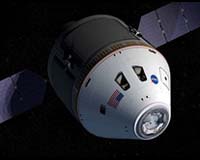| . |  |
. |
Pasadena CA (SPX) Nov 10, 2009 "We're back!" said Louis Friedman, Executive Director of The Planetary Society. "With an even more ambitious solar sail program than our last venture." The Planetary Society has announced LightSail, a plan to sail a spacecraft on sunlight alone by the end of 2010. The new solar sail project, boosted by a one-million-dollar anonymous donation, was unveiled at an event on Capitol Hill in Washington, D.C on the 75th anniversary of the birth of Planetary Society co-founder Carl Sagan, a long-time advocate of solar sailing. LightSail is an innovative program that will launch three separate spacecraft over the course of several years, beginning with LightSail-1, which will demonstrate that sunlight alone can propel a spacecraft in Earth orbit. LightSails-2 and 3, more ambitious still, will reach farther into space. "We are going to merge the ultra-light technology of nanosats with the ultra-large technology of solar sails in an audacious new program," said Friedman. Taking advantage of the technological advances in micro- and nano-spacecraft over the past five years, The Planetary Society will build LightSail-1 with three Cubesat spacecraft. One Cubesat will form the central electronics and control module, and two additional Cubesats will house the solar sail module. Cameras, additional sensors, and a control system will be added to the basic Cubesat electronics bus. "To get sunlight to push us through space, we need a large sail attached to a small spacecraft. Lightsail-1 fits into a volume of just three liters before the sails unfurl to fly on light. It's elegant," exclaimed Planetary Society Vice President Bill Nye the Science Guy. LightSail seeks to create and prove solar sail technologies that in a few years can - monitor the Sun for solar storms, - provide stable Earth observation platforms, and - explore our solar system without carrying heavy propellants. Sailing on light pressure (from lasers rather than sunlight) is also the only known technology that might carry out practical interstellar flight, helping pave our way to the stars. "Sailing on light is a pathway to the stars, but on that path are also some very important scientific and engineering applications that help us understand and protect our own planet and explore other worlds," remarked Planetary Society President Jim Bell. Reflected light pressure, not the solar wind, propels solar sails. The push of photons against a mirror-bright surface can continuously change orbital energy and spacecraft velocity. LightSail-1 will have four triangular sails, arranged in a diamond shape resembling a giant kite. Constructed of 32 square meters of mylar, LightSail-1 will be placed in an orbit over 800 kilometers above Earth, high enough to escape the drag of Earth's uppermost atmosphere. At that altitude the spacecraft will be subject only to the force of gravity keeping it in orbit and the pressure of sunlight on its sails increasing the orbital energy. Lightsail-2 will demonstrate a longer duration flight to higher Earth orbits. LightSail-3 will go to the Sun-Earth Libration Point, L1, where solar sails could be permanently placed as solar weather stations, monitoring the geomagnetic storms from the Sun that potentially endanger electrical grids and satellite systems around Earth. The Planetary Society's attempt in 2005 to launch the world's first solar sail, Cosmos 1, was scuttled when its launch vehicle, a Russian Volna rocket, failed to reach Earth orbit. But the organization's membership never lost faith in the goal to sail on wings of light, and now, thanks to their continued support - including the million dollar private (and anonymous) donation - the new LightSail project will begin. Sagan's widow and collaborator, Ann Druyan - whose Cosmos Studios was the Society's partner and principal sponsor of Cosmos 1 - serves as Chief Advisor to the current project. Druyan commented, "Carl and I once wrote 'We have lingered too long on the shores of the cosmic ocean. It's time to set sail for the stars.' We are celebrating his birthday by announcing the maiden voyages of a fleet of ships conceived to fulfill that mythic imperative. I think I know what this would have meant to him." James Cantrell, CEO of Strategic Space Inc, is Project Manager of LightSail-1. Stellar Exploration will build the spacecraft in San Luis Obispo, CA. Other team participants include the Cubsesat development group at California Polytechnic University, San Luis Obispo, and a team at Russia's Space Research Institute. Share This Article With Planet Earth
Related Links The Planetary Society LightSail Space Tourism, Space Transport and Space Exploration News
 Defining A Flexible Path To Human Space Exploration
Defining A Flexible Path To Human Space ExplorationBethesda MD (SPX) Nov 03, 2009 The U.S. is approaching a near term fork in the path to Human Space Exploration. As it turns out the flexible path defined by the Augustine Committee would not be very flexible unless Shuttle is extended and Orion is reconfigured to permit longer voyages with provisions for repair of micrometeoroid penetrations and systems repair as well as for more habitation room. Orion's current design ... read more |
|
| The content herein, unless otherwise known to be public domain, are Copyright 1995-2009 - SpaceDaily. AFP and UPI Wire Stories are copyright Agence France-Presse and United Press International. ESA Portal Reports are copyright European Space Agency. All NASA sourced material is public domain. Additional copyrights may apply in whole or part to other bona fide parties. Advertising does not imply endorsement,agreement or approval of any opinions, statements or information provided by SpaceDaily on any Web page published or hosted by SpaceDaily. Privacy Statement |